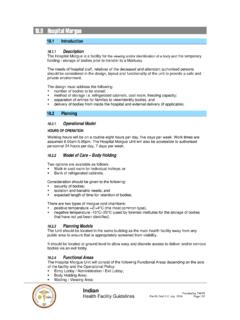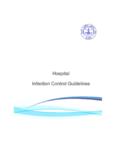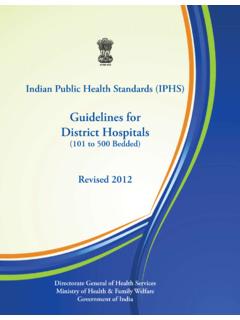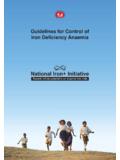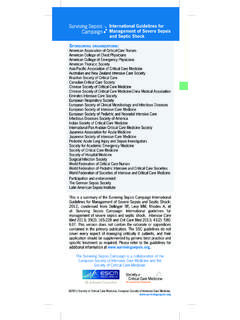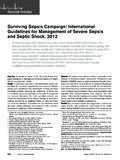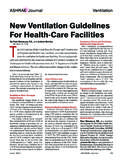Transcription of 18.0 Hospital Morgue - Health Facility Guidelines
1 Indian Health Facility Guidelines Provided by TAHPI Part B; Draft , July 2014 Page 122 Hospital Morgue Introduction Description The Hospital Morgue is a Facility for the viewing and/or identification of a body and the temporary holding / storage of bodies prior to transfer to a Mortuary. The needs of Hospital staff, relatives of the deceased and attendant authorised persons should be considered in the design, layout and functionality of the unit to provide a safe and private environment. The design must address the following: number of bodies to be stored; method of storage refrigerated cabinets, cool room, freezing capacity; separation of entries for families to view/identify bodies, and delivery of bodies from inside the Hospital and external delivery (if applicable). Planning Operational Model HOURS OF OPERATION Working hours will be on a routine eight hours per day, five days per week.
2 Work times are assumed The Hospital Morgue Unit will also be accessible to authorised personnel 24 hours per day, 7 days per week. Model of Care Body Holding Two options are available as follows: Walk-in cool room for individual trolleys; or Bank of refrigerated cabinets. Consideration should be given to the following: security of bodies; isolation and bariatric needs; and expected length of time for retention of bodies. There are two types of Morgue cold chambers: positive temperature +2/+4 C (the most common type), negative temperature -15 C/-25 C (used by forensic institutes for the storage of bodies that have not yet been identified). Planning Models The Unit should be located in the same building as the main Health Facility away from any public area to ensure that is appropriately screened from visibility. It should be located at ground level to allow easy and discrete access to deliver and/or remove bodies via an exit lobby.
3 Functional Areas The Hospital Morgue Unit will consist of the following Functional Areas depending on the size of the Facility and the Operational Policy: Entry Lobby / Administration / Exit Lobby; Body Holding Area; Waiting / Viewing Area; Indian Health Facility Guidelines Provided by TAHPI Part B; Draft , July 2014 Page 123 Staff Area. ENTRY LOBBY / ADMINISTRATION / EXIT LOBBY The Entry and Exit Lobbies form part of a single space with direct access to the Body Holding Area. The area should include hand basin; workstation for body registration and removal details; parking space for the transport trolley; parking space for a hoist / elevating trolley. BODY HOLDING AREA The Body Holding Area provides refrigerated space for the temporary storage of bodies. The area should allow for the following: Separate spaces / cabinets should be allowed for isolation; Manoeuvring space in front of refrigerated cabinets to insert/withdraw the trays; 3 square metres is required for a body on a loose tray or trolley in a cool room.
4 WAITING / VIEWING AREA The area should allow for the following: Discrete entrance away from the main Hospital to the Waiting Area for relatives, police and others; Direct visibility into the adjoining Viewing Area. STORAGE The area should allow for the following dedicated areas: Lockable storage area for the deceased s personal effects; Clean linen area; Cleaning materials and agents; Used linen collection area; Plastic body bags and sealing machine area. STAFF AREA The area should allow for the following: Staff areas comprising of office, workstations, meeting / teaching rooms and amenities; Office for use by the pathologist and police. Functional Relationships EXTERNAL Mortuary / Holding facilities shall be accessible through an exterior entrance and shall be located to avoid the need for transporting bodies through public areas.
5 It should also be located in close proximity to Anatomical Pathology laboratories and relevant clinical areas for transportation of laboratory specimens. INTERNAL The Waiting Area and Viewing Area should be collocated however there should be no access to other sections of the Morgue for viewers. Entry Lobby, Exit Lobby and Administrative Area form part of a single area. Indian Health Facility Guidelines Provided by TAHPI Part B; Draft , July 2014 Page 124 Design Accessibility EXTERNAL Morgue Unit is to have separate access as follows: direct access from the Hospital for delivery of the body; direct but separate and discreet access for relatives of the deceased from all relevant areas of the Hospital to Morgue waiting / viewing area; adequate access for funeral directors for vehicle parking and discrete, weather protected, facilities for the collection of bodies; adequate access for ambulances delivering bodies; adequate access for police vehicles.
6 INTERNAL The Body Holding Room is to have direct access to/from: the Hospital corridor for use by staff; Viewing Room; discreet access from body hold / cool room to hearse and ambulance parking bays. Infection Control Bodies stored in the Morgue which may contain infectious diseases that must be contained. Cleaned instruments and materials shall be re-circulated under normal procedures through the Sterile Supply Unit or autoclaved within the Morgue Unit. The unit shall be designed to control infection utilising the following: layout designed to minimise cross contamination in work areas; provision of a small wash-down / disposal / booting area; provision of an adequate number of hand wash facilities; provision of appropriate cleaning, waste storage and waste disposal; use of suitable materials and finishes; specimen storage facilities; first aid facilities; adequate isolation of space and ventilation systems which present potential hazard.
7 Environmental Considerations GENERAL The Morgue Unit needs to be designed to provide staff with sufficient space, working surfaces and appropriate equipment to safely carry out their duties. INTERIOR DESIGN The interior design of the Morgue Unit shall have due consideration for the following as primary items of design: infection control; cooling and ventilation. ACOUSTICS Acoustic design shall ensure that conversations in adjoining rooms cannot he overheard by relatives in the viewing area. Please refer to Part C, Acoustic Solutions for Healthcare Facilities Space Standards and Components ERGONOMICS The Morgue Unit shall be ergonomically designed to any potential avoid injury to staff, patients, visitors or maintenance personnel. Indian Health Facility Guidelines Provided by TAHPI Part B; Draft , July 2014 Page 125 ACCESS AND MOBILITY Where necessary the layout shall comply with the requirements of the Americans with Disabilities Act (ADA) Accessibility Guidelines for Building Facilities.
8 Safety and Security SAFETY The interior design of the Morgue Unit shall consider the impact of finishes, surfaces and fittings on safety including the following: floor covering selection; adequate drainage; protection from protrusions or sharp edges; stability and height of equipment or fittings; adequate protection against infection and any other hazards; SECURITY The security aspects of the Morgue Unit shall consider the following: deceased bodies; valuables left on the body; specimens removed during autopsy; staff personal belongings and security; access and egress, particularly after hours. Finishes Refer also to Part C of these Guidelines . CEILING FINISHES Ceilings must be washable, impermeable and non porous. FLOOR FINISHES Floor finishes shall be non-slip for all wet areas or areas subject to water. It should be impervious, easy to clean, sealed with coving at the edges and have adequate drainage.
9 Drains should be fitted with appropriately filtered traps for ease of hosing down. WALL FINISHES Wall surfaces in the body holding area should be washable and/or scrubbable. Fixtures and Fittings Refer also to Part C of these Guidelines AND Standard Components for Fixtures and Fittings. The equipment layout of the Morgue Unit shall ensure: adequate provision for operation and maintenance; provision of services as required; door sized to allow for delivery and removal of the equipment; design for the required heat loads; Adequate provision for weight loads. SAFETY SHOWERS AND EYE WASHES Provide safety shower and eye wash or eye / face wash equipment. Building Service Requirements Refer also to Part E of these Guidelines . Indian Health Facility Guidelines Provided by TAHPI Part B; Draft , July 2014 Page 126 AIR-CONDITIONING, HEATING and VENTIALLATION The temperature of the body holding area should be maintained within a comfortable range not exceeding 20-21 C.
10 The ventilation system should be isolated from other ventilation systems by being designed to minimise the spread of odours and airborne pathogens. ALARMS The operating temperatures of all cooled and freezing facilities should be continuously monitored and fitted with alarms which are activated when the temperature exceeds a predetermined level. LIGHTING Provide adequate lighting in all areas. POWER SUPPLY Provide protective covers to power supply outlets to protect outlets from wetting. Provide an emergency back-up system for the power supply to the refrigeration, high priority equipment and illumination. Components of the Unit Standard Components The Hospital Morgue Unit will contain Standard Components. Provide Standard Components to comply with details in the Standard Components described in these Guidelines . Refer also to Standard Components Room Data Sheets and Room Layout Sheets.
